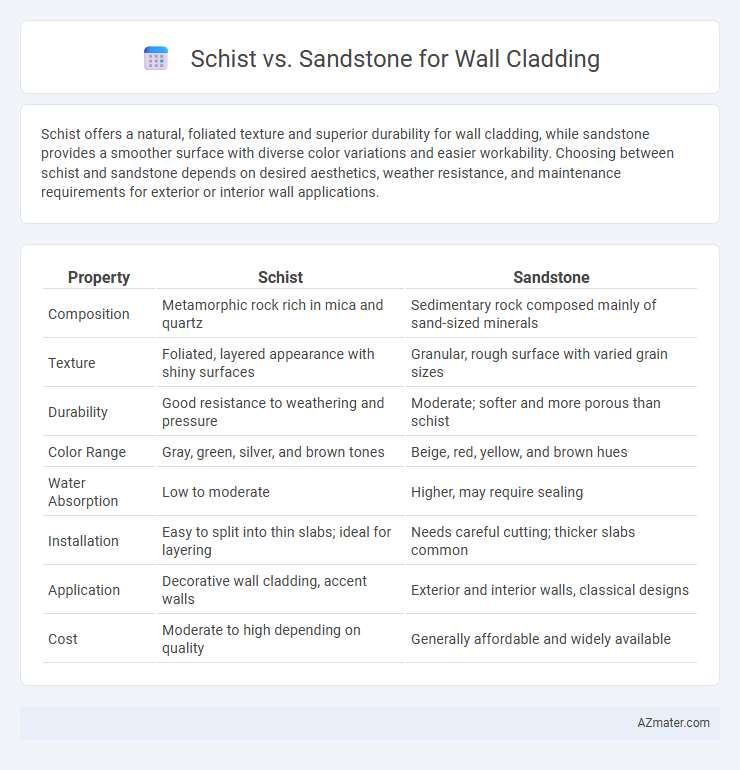Schist offers a natural, foliated texture and superior durability for wall cladding, while sandstone provides a smoother surface with diverse color variations and easier workability. Choosing between schist and sandstone depends on desired aesthetics, weather resistance, and maintenance requirements for exterior or interior wall applications.
Table of Comparison
| Property | Schist | Sandstone |
|---|---|---|
| Composition | Metamorphic rock rich in mica and quartz | Sedimentary rock composed mainly of sand-sized minerals |
| Texture | Foliated, layered appearance with shiny surfaces | Granular, rough surface with varied grain sizes |
| Durability | Good resistance to weathering and pressure | Moderate; softer and more porous than schist |
| Color Range | Gray, green, silver, and brown tones | Beige, red, yellow, and brown hues |
| Water Absorption | Low to moderate | Higher, may require sealing |
| Installation | Easy to split into thin slabs; ideal for layering | Needs careful cutting; thicker slabs common |
| Application | Decorative wall cladding, accent walls | Exterior and interior walls, classical designs |
| Cost | Moderate to high depending on quality | Generally affordable and widely available |
Introduction to Wall Cladding Materials
Schist and sandstone are popular natural stone choices for wall cladding due to their durability and aesthetic appeal. Schist offers a layered, flaky texture with rich mineral content, enhancing architectural character through its natural shimmer and rugged surface. Sandstone provides a softer, warm-toned finish with excellent weather resistance, making it ideal for both exterior and interior cladding applications.
Overview of Schist as a Wall Cladding Option
Schist is a metamorphic rock characterized by its foliated texture and high mica content, offering a unique, shimmering appearance that enhances wall cladding aesthetics. Its durability and resistance to weathering make schist an excellent choice for exterior wall cladding, providing long-lasting structural integrity and natural insulation. The stone's varied color palette and ability to be split into thin layers allow for diverse design possibilities, making it ideal for both modern and traditional architectural styles.
Overview of Sandstone as a Wall Cladding Material
Sandstone as a wall cladding material offers exceptional durability and natural beauty, characterized by its granular texture and warm, earthy tones that enhance architectural aesthetics. Its porosity allows for excellent breathability, making it ideal for regulating indoor moisture and temperature in various climates. Sandstone's versatility in thickness and finish options provides a customizable solution for both traditional and contemporary wall cladding applications.
Key Differences Between Schist and Sandstone
Schist features a foliated texture with visible mineral grains, offering enhanced durability and resistance to weathering compared to sandstone's granular, softer composition prone to erosion. Sandstone typically displays uniform coloration and smoother surfaces, making it easier to cut and install but less ideal for high-impact areas. Schist's natural cleavage planes provide unique aesthetic patterns and superior structural strength, whereas sandstone is valued for its warm tones and versatility in design applications.
Aesthetic Appeal: Schist vs Sandstone
Schist offers a distinctive aesthetic appeal with its shimmering, layered texture and natural metallic flecks, creating a dynamic, eye-catching wall cladding that enhances contemporary and rustic designs. Sandstone presents a warm, earthy palette with smooth or slightly rough surfaces, providing a timeless and versatile look that complements traditional and modern architecture alike. Both materials deliver unique visual qualities, with schist emphasizing sparkle and texture, while sandstone highlights subtle color variation and natural warmth.
Durability and Longevity Comparison
Schist exhibits superior durability for wall cladding due to its foliated structure, which allows it to withstand weathering and mechanical stress better than sandstone. Sandstone, while aesthetically appealing, often contains softer minerals that may erode more quickly under harsh environmental conditions, reducing its longevity. Overall, schist's resistance to moisture penetration and freeze-thaw cycles makes it a more long-lasting cladding option compared to sandstone.
Installation Process: Schist vs Sandstone
Schist wall cladding requires careful handling due to its layered structure, which demands precise alignment and secure fixing methods to prevent delamination and maintain durability. Sandstone, being more uniform and denser, allows for easier cutting and installation, with standard masonry anchors typically sufficient for stable attachment. Both materials necessitate a professional approach to ensure proper adhesion and weather resistance during the installation process.
Maintenance Requirements for Each Stone
Schist requires more frequent sealing due to its foliated texture, which can absorb moisture and stain easily, making regular maintenance essential to preserve its appearance in wall cladding. Sandstone, with its sturdier, granular surface, typically demands less intensive upkeep but should still be cleaned regularly to prevent dirt buildup and maintain its natural color. Both stones benefit from occasional professional cleaning and inspection to address any weathering or damage promptly, ensuring long-term durability and aesthetic appeal.
Cost Analysis: Schist vs Sandstone
Schist typically costs more than sandstone for wall cladding due to its unique foliated texture and limited quarry sources, resulting in higher extraction and processing expenses. Sandstone offers a more economical choice with widespread availability and easier cutting, making it a cost-effective option for large-scale projects. Installation costs vary slightly, but the overall budget impact is primarily driven by the material price difference between schist and sandstone.
Choosing the Right Stone for Your Wall Cladding Needs
Schist offers a distinctive, textured appearance with natural mica flakes that reflect light, making it ideal for decorative wall cladding where aesthetic appeal is crucial. Sandstone provides durability and a smooth, consistent surface with excellent weather resistance, suitable for both interior and exterior wall cladding projects requiring strength and longevity. When choosing the right stone for your wall cladding needs, consider the environmental exposure, design preferences, and maintenance requirements of each material to ensure optimal performance and visual impact.

Infographic: Schist vs Sandstone for Wall Cladding
 azmater.com
azmater.com